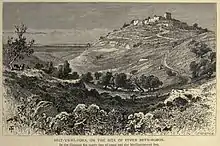Bethoron
Bethoron, also Beth-Horon meaning "House of Horon" (Hebrew: בֵית־חוֹרֹ֔ן; in LXX Ancient Greek: Ὡρωνείν) was an ancient biblical town strategically located on the Gibeon-Aijalon road, guarding the "ascent of Beth-Horon". Upper Bethoron appears in Joshua 16:5 and Lower Bethoron in Joshua 16:3 and 1 Chronicles 7:24[1] and I Maccabees 3:16.

Etymology
| bꜣtꜣ(j) ḥwꜣr(l)n[2][3] in hieroglyphs |
|---|
The Hebrew name Bethoron (Beit Horon, בית חורון) is derived from the name of an Egypto-Canaanite deity, Horon, mentioned in Ugaritic literature.[1][4][5] The city is mentioned among the cities and towns smitten by Sheshonq I in his inscription at the Temple of Karnak as Batae Houarn.[2][3]
History
According to 1 Chronicles 7:24,[6] Lower Bethoron was built by She'era, daughter of Beriah, son of Ephraim.[1] Eusebius' Onomasticon mentions the 'twin villages' and St. Jerome describes them as 'little hamlets.' [1] From Egyptian sources (Muller, As. und Europa, etc.) it appears that Bethoron was one of the places conquered by Shishak of Egypt from Rehoboam.
The borderline between Benjamin and Ephraim passed alongside the two Bethorons (Joshua 16:5;[7] 21:22[8]) who belonged to the latter Israelite tribe and therefore, later on, to the Northern Kingdom of Israel, while the tribe of Benjamin adhered to the Kingdom of Judah. Solomon "built Beth-horon the upper, and Beth-horon the nether, fortified cities, with walls, gates, and bars" (2 Chronicles 8:5;[9] 1 Kings 9:17[10]). One or both of the towns was a Levitical city (Joshua 21:22; 2 Chronicles 6:53[11]).
When Joshua utterly defeated the kings of the Amorites "he killed a large number of them at Gibeon, and chased them by the way of the 'Ascent of Beth-horon.'(Joshua 10:10[12]) When the Philistines opposed King Saul at Michmash they sent a company of their men to hold "the way of Beth-horon."
This pass ascends from the plain of Aijalon (now Ayalon-Canada Park) and climbs to Beit Ur al Tahta (1,210 ft.). It then ascends along the ridge, with valleys lying to north and south, and reaches Beit Ur al-Fauqa (2,022 ft.). Traces of the ancient Roman paving are visible. Since the days of Joshua the region has been the scene of many battles. The Syrian general Seron was defeated here by Judas Maccabeus (1 Macc. 3:13-24[13]) in the Battle of Beth Horon. Six years later Nicanor, retreating from Jerusalem, was defeated and slain. (1 Macc. 7:39[14]); (Josephus, Antiquities Bk12 Ch10:5[15])
Bacchides repaired Beth-horon, "with high walls, with gates and with bars and in them he set a garrison, that they might work malice upon ("vex") Israel" (1 Macc. 9:50,51[16]). Later, the Jews fortified it against Holofernes (Judith 4:4,5[17]).
In the Battle of Beth Horon (66) in the year 66 CE, the first decisive Jewish victory in the First Jewish-Roman War the Roman general Cestius Gallus was driven in headlong flight before the Jews.[18]
Eusebius mentions the two Bethorons in their Biblical contexts, noting Joshua's victory and the fortification by King Solomon.[19]
The two Palestinian Arab Muslim villages of Beit Ur al-Fauqa and Beit Ur al-Tahta preserve the Hebrew-Canaanite name,[1] and have been identified as the sites of Upper and Lower Bethoron.[5] In 1915, the Palestine Exploration Fund wrote that changes in the main road to Jerusalem had left the Bethoron route "forsaken" and "almost forgotten".
The Israeli settlement of Beit Horon was founded in 1977 on a site adjacent to the two towns. Highway 443 follows part of the ancient road.
Archaeology
Archaeological finds indicate that the lower town was established before the upper one. Potsherds from the Late Bronze Age onward were discovered at Lower Beit Ur, whereas those in Upper Beit Ur date only from the Iron Age onward.[1]
References
- Eugenio Alliata (2000-12-19). "Bethoron (Bayt Ur)". Studium Biblicum Franciscanum. Archived from the original on 2008-08-29. Retrieved 2007-09-12.
- Wallis Budge, E. A. (1920). An Egyptian hieroglyphic dictionary: with an index of English words, king list and geological list with indexes, list of hieroglyphic characters, coptic and semitic alphabets, etc. Vol II. John Murray. p. 978.
- Gauthier, Henri (1925). Dictionnaire des Noms Géographiques Contenus dans les Textes Hiéroglyphiques Vol. 2. p. 9.
- William Albright (December 1941). "The Egypt-Canaanite God Haurôn". Bulletin of the American Schools of Oriental Research. No. 84 (84): 7–12. JSTOR 1355138.
- John Gray (January 1949). "The Canaanite God Horon". Journal of Near Eastern Studies. 8 (1): 27–34. doi:10.1086/370902. JSTOR 542437.
- 1 Chronicles 7:24
- Judges 16:5
- Judges 21:22
- 2 Chronicles 8:59
- 1 Kings 9:17
- 2 Chronicles 6:53
- Joshua 10:10
- 1 Maccabees 3:13–3:24
- 1 Maccabees 7:39
- Josephus, Antiquities of the Jews Bk12 Ch10:5
- 1 Maccabees 9:50–9:51
- Judith 4:4–4:5
- Paul K. Davis, 100 Decisive Battles from Ancient Times to the Present: The World’s Major Battles and How They Shaped History (Oxford: Oxford University Press, 1999), 71.
- Sharon, 1999, p. 165
Bibliography
- Masterman, E. W. G. (1915).BETH-HORON. International Standard Bible Encyclopedia, Orr, James, retrieved December 9, 2005.
- Sharon, Moshe (1999). Corpus Inscriptionum Arabicarum Palaestinae, B-C. 2. BRILL. ISBN 9004110836.
External links
- Israeli Antiquities Authority report on the discovery of a burial cave in Beit 'Ur al-Tahta
